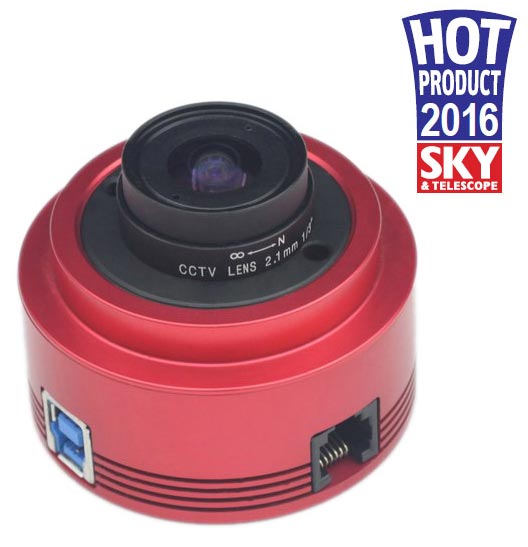ZWO ASI224MC – Extremely Low Noise with Superior NIR Sensitivity
ZWO’s ASI224MC one shot colour astronomy camera has some very noteworthy features. It uses a Sony IMX224 CMOS sensor with Exmor and NIR Technology. Read noise is extremely low while having amazing sensitivity in the near infrared. Fast USB3.0 speed makes it ideal for imaging Solar System and small DSOs such as planetary nebulae.
Super Low Read Noise less than 1e which can compare with sCMOS or EMCCD sensors
Many images of faint nebulae or galaxies require long exposure times, especially to bring out faint details. Digital sensors and processing software allows stacking multiple exposures. You often hear “..a stack of 6 x 10 minute exposures” giving 60 minutes total exposure. The big obstacle may be getting your mount to track precisely enough for 10 minutes.
Why not just take 60 x 1 minute shots? Or 120 x 30 second shots? Or even 3600 x 1 second shots to get the same result.
The answer is read noise. Every time the sensor is read inherent uncertainty in the pixel values is included in the data – this is the “read noise”. Long exposures produce good signal with low read noise. Images with many short exposures include read noise from every subframe – so you don’t get the same result.
ZWO’s ASI224MC has very low read noise. So low in fact that it is becoming possible to thousands of short exposures and add them without a significant penalty in read noise. The age of “lucky imaging” is approaching.

Transmission characteristics of the ASI224MC’s bayer array

ZWO ASI224MC Specifications
| Sensor | 1/3” CMOS IMX224 |
| Resolution | 1.2Mega Pixels 1304X976 |
| Pixel Size | 3.75µm |
| Sensor Size | 4.8mm*3.6mm |
| Diagonal | 6.09mm |
| Exposure Range | 32µs-1000s |
| ROI | Supported |
| Binning | 2×2 binning supported |
| Back focus distance | 12.5mm |
| Shutter Type | Rolling Shutter |
| Protect window | AR coated window |
| Operating System Compatibility | Mac, Windows, Linux |
| Interface | USB3.0/USB2.0 |
| Bit rate | 12bit output(12bit ADC) |
| Adapter | 2″ / 1.25″ / M42X0.75 |
| Dimensions | 62 mm Diameter |
| Weight | 100g |
| Working Temperature | -5°C—45°C |
| Storage Temperature | -20°C—60°C |
| Working Relative Humidity | 20%—80% |
| Storage Relative Humidity | 20%—95% |


Reviews
There are no reviews yet.